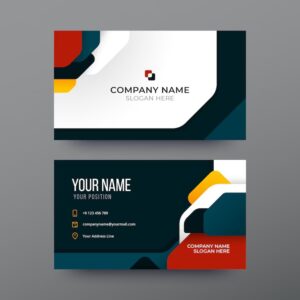Where communication often occurs through screens and emails, the humble business card remains a tangible and powerful tool for making lasting impressions. While traditional business cards serve their purpose, creative business cards take networking to the next level. They act as miniature ambassadors for your brand, showcasing your personality, professionalism, and creativity in a small yet impactful format. This article explores the significance of creative business cards, the elements that make them stand out, and how they can be designed to leave a lasting impression.
The Importance of Creative Business Cards
Creative Business cards have been a staple of professional interactions for centuries. Despite the rise of digital networking tools, they continue to hold relevance due to several key reasons:
- Tangibility: A business card provides a physical reminder of a meeting or interaction. Unlike a digital contact, which can be easily forgotten or overlooked, a business card is something tangible that a person can hold onto.
- First Impressions: A well-designed business card can create a positive first impression. It conveys a sense of professionalism and attention to detail, which can be crucial in establishing credibility and trust.
- Convenience: Exchanging business cards is a quick and efficient way to share contact information. In situations where digital connectivity might be limited, a business card ensures that you can still provide your details.
- Branding: Business cards are an extension of your brand. They offer a unique opportunity to reinforce your brand identity through design elements such as logos, colors, and typography.

Elements of a Creative Business Card
A creative business card goes beyond the standard format of name, title, company, and contact information. It incorporates unique design elements that capture attention and make a memorable statement. Here are some key elements that contribute to a creative business card:
- Unique Shapes and Sizes: While standard business cards are typically rectangular, creative cards can take on various shapes and sizes. Die-cutting techniques allow for cards in the shape of objects related to the business, such as a camera for a photographer or a house for a real estate agent.
- Material Choices: Traditional business cards are printed on paper or cardstock, but creative cards can utilize a variety of materials. Options include wood, metal, plastic, and even fabric. Each material choice can convey a different message about the brand.
- Interactive Elements: Adding interactive features to a business card can make it more engaging. This can include elements such as pop-ups, fold-outs, or movable parts. For example, a business card for a graphic designer might have a section that unfolds to reveal a mini portfolio.
- Innovative Printing Techniques: Techniques such as embossing, debossing, foil stamping, and spot UV coating can add texture and visual interest to a business card. These techniques can highlight specific elements of the design, making the card more visually appealing.
- Minimalist Design: Sometimes, less is more. A minimalist design with ample white space can make a business card look clean and sophisticated. It can also help important information stand out more clearly.
- Typography: The choice of fonts and how they are used can greatly impact the overall look of a business card. Creative use of typography can add personality and make the card more memorable.
Designing a Creative Business Card
Designing a creative business card involves more than just aesthetic considerations. It requires a thoughtful approach to ensure that the card effectively communicates the desired message and serves its functional purpose. Here are some steps to guide the design process:
- Define Your Brand Identity: Before starting the design, it is crucial to have a clear understanding of your brand identity. This includes your brand’s values, personality, and target audience. Your business card should reflect these aspects to create a cohesive brand experience.
- Determine the Key Information: Identify the essential information that needs to be included on the business card. This typically includes your name, title, company name, contact information, and possibly a logo. Consider the hierarchy of this information and how it will be presented on the card.
- Choose a Suitable Layout: The layout of the business card should be well-organized and visually balanced. Experiment with different arrangements of text and graphics to find a layout that is both aesthetically pleasing and functional.
- Select Colors Wisely: Color choices should align with your brand’s color palette and evoke the desired emotions. Consider the psychology of colors and how they can influence perceptions of your brand. Ensure that the colors used on the card provide sufficient contrast for readability.
- Incorporate Visual Elements: Add visual elements such as logos, icons, and graphics to enhance the design. These elements should be relevant to your brand and add value to the overall composition. Avoid overcrowding the card with too many visuals.
- Choose Quality Materials: The choice of materials can significantly impact the perception of your business card. High-quality materials can convey a sense of professionalism and attention to detail. Consider experimenting with different textures and finishes to add a unique touch.
- Test the Design: Before finalizing the design, it is important to test it. Print a sample to see how the design looks in physical form. Check for readability, color accuracy, and overall visual appeal. Make necessary adjustments based on the feedback received.

Examples of Creative Business Cards
To inspire your own business card design, here are a few examples of creative business cards that have made a lasting impression:
- Transparent Business Cards: Cards made from transparent plastic can create a sleek and modern look. They can be layered with different colors and designs to create a unique visual effect.
- Interactive Business Cards: Some business cards incorporate interactive elements, such as QR codes that link to a website or a mini fold-out brochure. These elements can engage the recipient and provide additional information about the business.
- Functional Business Cards: Cards that serve a dual purpose can be highly memorable. For example, A business card that doubles as a bottle opener or a mini ruler adds value beyond just contact information.
- Eco-Friendly Business Cards: Using recycled or sustainable materials for business cards can convey a commitment to environmental responsibility. These cards can be made from materials such as recycled paper, seed paper, or bamboo.
- Luxurious Business Cards: High-end business cards made from premium materials such as metal, wood, or thick cardstock with special finishes can create a luxurious impression. These cards often feature embossing, foil stamping, or spot UV coating QR code.
Conclusion
Creative business cards are more than just a means of exchanging contact information. They are powerful tools for making lasting impressions and reinforcing brand identity. By incorporating unique shapes, materials, interactive elements, and innovative design techniques, you can create a business card that stands out in a crowded marketplace. A well-designed business card can leave a lasting impression, spark conversations, and open doors to new opportunities. In a world where first impressions matter, investing in a creative business card is a step towards making a memorable impact.


